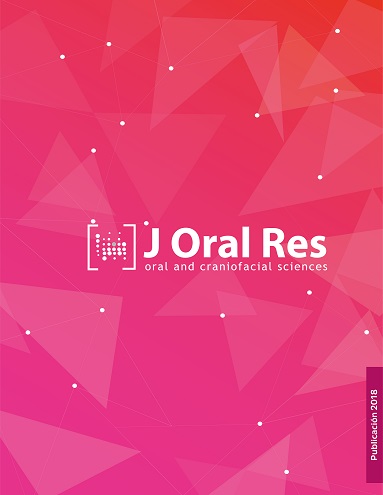Facial antibioma formation: A Case Report.
Abstract
Odontogenic infections are associated with a variety of microorganisms. Antibiotics are commonly used for the management of various dental infections and have a proven role in decreasing morbidity and mortality caused by infectious diseases. The frequent and over usage of antibiotics has been associated with a number of consequences such as the selection of drug resistant strains, and the formation of antibiomas. Antibiomas are characterized by the formation of a localized pathology surrounded by thick fibrous tissues in response to long term antibiotics use. An established antibioma is characterized by a tough fibrous swelling accompanied by painful or painless swelling, intermittent fever and constitutional symptoms. In this article, we are reporting the case of a facial antibioma formed due to prolonged use of antibiotics prescribed for a residual periapical infection following endodontic treatment. In addition, the association of using antibiotics in this context is discussed.
References
2. Bahl R, Sandhu S, Singh K, Sahai N, Gupta M. Odontogenic infections: Microbiology and management. Contemp Clin Dent. 2014;5(3):307–11.
3. Poveda Roda R, Bagan JV, Sanchis Bielsa JM, Carbonell Pastor E. Antibiotic use in dental practice. A review. Med Oral Patol Oral Cir Bucal. 2007;12(3):E186–92.
4. Dar-Odeh NS, Abu-Hammad OA, Al-Omiri MK, Khraisat AS, Shehabi AA. Antibiotic prescribing practices by dentists: a review. Ther Clin Risk Manag. 2010;6:301–6.
5. Muzaffar D, Mahdey HM, Sonjaya D, Zafar MS. Tendency of self-medication among various malaysian ethnicities. Br J Pharmacol. 2016;9(2):1–7.
6. Afolabi AO, Akinmoladun VI, Adebose IJ, Elekwachi G. Self-medication profile of dental patients in Ondo State, Nigeria. Niger J Med. 2010;19(1):96–103.
7. Longman LP, Preston AJ, Martin MV, Wilson NH. Endodontics in the adult patient: the role of antibiotics. J Dent. 2000;28(8):539–48.
8. Palmer NO, Martin MV, Pealing R, Ireland RS. An analysis of antibiotic prescriptions from general dental practitioners in England. J Antimicrob Chemother. 2000;46(6):1033–5.
9. Demirbas F, Gjermo PE, Preus HR. Antibiotic prescribing practices among Norwegian dentists. Acta Odontol Scand. 2006;64(6):355–9.
10. Marra F, George D, Chong M, Sutherland S, Patrick DM. Antibiotic prescribing by dentists has increased: Why? J Am Dent Assoc. 2016;147(5):320–7.
11. Narang S, Khurana MS. Use of antibiotics in Pediatric Dentistry: Not a child's play. Int J Periodontol Implantol. 2017;2(4):109–11.
12. Alrahabi M, Sohail Zafar M. Evaluation of root canal morphology of maxillary molars using cone beam computed tomography. Pak J Med Sci. 2015;31(2):426–30.
13. Zafar MS, Alrahabi M. Cone Beam Computed Tomography for Exploring Morphology of Mandibular First Molar. Br J Med Med Res. 2015;6(5):514–21.
14. American Dental Association Council on Scientific Affairs. Combating antibiotic resistance. J Am Dent Assoc. 2004;135(4):484–7.
15. Kuriyama T, Nakagawa K, Karasawa T, Saiki Y, Yamamoto E, Nakamura S. Past administration of beta-lactam antibiotics and increase in the emergence of beta-lactamase-producing bacteria in patients with orofacial odontogenic infections. Oral Surg Oral Med Oral Pathol Oral Radiol Endod. 2000;89(2):186–92.
16. Bascones-Martínez A, Aguirre-Urízar JM, Bermejo-Fenoll A, Blanco-Carrión A, Gay-Escoda C, González-Moles MA, Gutiérrez-Pérez JL, Jiménez-Soriano Y, Liébana-Ureña J, López-Marcos JF, Maestre-Vera JR, Perea-Pérez EJ, Prieto-Prieto J, Vicente-Rodríguez JC. Documento de consenso sobre el tratamiento antimicrobiano de las infecciones bacterianas odontogénicas. Av Odontoestomatol. 2005;6(1):311–9.
17. Gay Escoda C, Berini Aytés L. Tratado de Cirugía Bucal. 1st Ed. Majadahonda (Madrid): Ergón; 2004.
18. Maestre Vera JR. Opciones terapéuticas en la infección de origen odontogénico. Med Oral Patol Oral Cir Bucal. 2004;9 Suppl:S19–31.
19. Kirkwood KL. Update on antibiotics used to treat orofacial infections. Alpha Omegan. 2003;96(4):28–34.
20. Groppo FC, Simões RP, Ramacciato JC, Rehder V, de Andrade ED, Mattos-Filho TR. Effect of sodium diclofenac on serum and tissue concentration of amoxicillin and on staphylococcal infection. Biol Pharm Bull. 2004;27(1):52–5.
21. de Cássia Bergamaschi C, Motta RH, Franco GC, Cogo K, Montan MF, Ambrosano GM, Rosalen PL, Del Fiol Fde S, Groppo FC. Effect of sodium diclofenac on the bioavailability of amoxicillin. Int J Antimicrob Agents. 2006;27(5):417–22.
22. Tsivou E, Melakopoulos I, Kotsiou A, Anagnostopoulou S, Tesseromatis C. Alterations in cefalosporin levels in the serum and mandible of hyperlipaedemic rats after co-administration of ibuprofen. Eur J Drug Metab Pharmacokinet. 2005;30(3):171–4.
23. Oh Y, Han HK. Pharmacokinetic interaction of tetracycline with non-steroidal anti-inflammatory drugs via organic anion transporters in rats. Pharmacol Res. 2006;53(1):75–9.
24. Pallasch TJ, In: Ingle JI, Bakland LK, eds. Pharmacology of Anxiety, Pain and Infection.Endodontics. 4th Ed. Malvern, PA: Williams and Wilkins; 1994.
25. Harneet S, Ambika G, Aarti S, Samidha K. Non surgical treatment of antibioma in oro-facial region. Int J Curr Res. 2017;9(8):56666–7.
26. Patil N, Kaul D, Tambuwala A, Pingal C, Sheikh MS, Pendharkar S. Large antibioma resulting from injudicious use of antibiotics: A case report. Int J Dent Med Res. 2015;1(5):89–92.
Keywords
This is an open-access article distributed under the terms of the Creative Commons Attribution License (CC BY 4.0). The use, distribution or reproduction in other forums is permitted, provided the original author(s) and the copyright owner(s) are credited and that the original publication in this journal is cited, in accordance with accepted academic practice. No use, distribution or reproduction is permitted which does not comply with these terms. © 2024.











